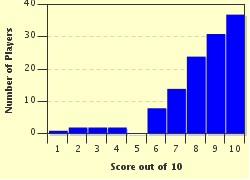Quiz Answer Key and Fun Facts
1. Humans have long admired strength, a broad chest, and bulging biceps, but which of these Victorians popularised and developed the sport of bodybuilding in the Western World?
2. Which of these should you definitely obtain before starting a bodybuilding regime?
3. A balanced exercise regime is necessary for the development of muscle groups. Which of these is not a recognised exercise in bodybuilding?
4. Dietary supplements are frequently used in sports. Which one of these supplements is illegal in professional bodybuilding?
5. Which 97-pound weakling went on to develop the "Dynamic Tension" system of bodybuilding exercises and became the classic face of male fitness of the twentieth century?
6. Bodybuilding as a sport is not open to women.
7. The major muscle groups in bodybuilding are generally referred to by shortened versions of their anatomical names. Which of these might a non-bodybuilder also call a "six pack"?
8. Was bodybuilding an accepted sport in the modern Olympic Games during the 20th century?
9. During a bodybuilding contest, there is a point where competitors pose to show off their physique. What is this called?
10. Practitioners of one form of bodybuilding maintain that their method is more focused on health and fitness than mainstream bodybuilding: what is this type of bodybuilding called?
Source: Author
Mistigris
This quiz was reviewed by FunTrivia editor
gtho4 before going online.
Any errors found in FunTrivia content are routinely corrected through our feedback system.

